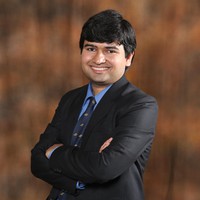Computer Architecture Computer Organization: CPU Cache and the Memory Hierarchy
Master CPU cache organization & ace computer organization, computer architecture exams!

Lectures -36
Resources -5
Duration -2.5 hours

30-days Money-Back Guarantee
Get your team access to 10000+ top Tutorials Point courses anytime, anywhere.
Course Description
Ace cache organization questions in competitive exams, job interviews, and computer organization and architecture course exams. Genuinely understand the implementation and working of caches in modern computers.
In this course, we will begin with an introduction to the memory hierarchy in modern computers. We will see why the computers employ several different types of memories, such as CPU registers, caches, main memory, hard disk, etc. After the introduction, the rest of the course focuses on caches. We will see that cache is a small but extremely fast piece of memory that sits between the fast CPU and slower RAM (main memory). The course is divided into the following nine sections: Introduction, Temporal locality, Performance implications of caches, Spatial locality, Writes in caches, Content addressable memory, Direct mapped caches, Set associative caches, Cache eviction, and hierarchical caches. The sections have several bite-sized lectures, practice problems, detailed animation examples illustrating concepts, and quizzes. Detailed solutions to the practice problems are included in the video and on the last page of the worksheets. Keys and explanations for the quiz questions are also provided. Specifically, the course will answer the following questions in detail.
1. Why do our computers have so many different types of memories?
2. What is a cache?
3. Why is a cache needed?
4. What data should be kept in a cache?
5. What are temporal and spatial locality?
6. How do caches exploit temporal locality?
7. How do caches exploit spatial locality?
8. What is the classic LRU cache replacement policy?
9. What are cache blocks? Why use them?
10. What is associativity in caches?
11. What is a fully associative cache?
12. What is a direct mapped cache?
13. What is a set associative cache?
14. How to determine whether a particular memory address will hit or miss in the cache?
15. How the address breakdown works for accessing data stored in fully associative, direct mapped, and set-associative caches?
16. How to modify data in caches?
17. What is a write-through cache?
18. What is a write-back cache?
19. How dirty are bits used in a write-back cache?
20. Can other cache eviction algorithms besides LRU be used?
21. How are caches organized in a hierarchy in modern computers?
Who this course is for:
- Anyone interested in learning about caches in modern computers could benefit from this course.
- Computer science undergraduate students taking a computer organization or computer architecture course could benefit from the course.
- You may (optionally) wish to print some of the material
Goals
What will you learn in this course:
What you will learn?
Why do our computers have so many different types of memories?
What is a cache?
Why is a cache needed?
What data should be kept in a cache?
What are temporal and spatial locality?
How do caches exploit temporal locality?
How do caches exploit spatial locality?
What is the classic LRU cache replacement policy?
What are cache blocks? Why use them?
What is associativity in caches?
What is a fully associative cache?
What is a direct mapped cache?
What is a set associative cache?
How to determine whether a particular memory address will hit or miss in the cache?
How the address breakdown works for accessing data stored in fully associative, direct mapped, and set-associative caches?
How to modify data in caches?
What is a write-through cache?
What is a write-back cache?
How dirty bits are used in a write-back cache?
What other cache eviction algorithms, besides LRU, can be used?
How are caches organized in a hierarchy in modern computers?
Prerequisites
What are the prerequisites for this course?
- No previous knowledge about caches or memory hierarchy needed. Everything you need to know about the topics will be covered.

Curriculum
Check out the detailed breakdown of what’s inside the course
Introduction
5 Lectures
-
Welcome to the course! 01:34 01:34
-
Memory hierarchy 10:05 10:05
-
What is a cache? 03:33 03:33
-
Cache--real world analogy 01:48 01:48
-
How to populate a cache? 02:21 02:21
Temporal locality
3 Lectures

Performance implications of caches
3 Lectures

Spatial locality
5 Lectures

Writes in caches
5 Lectures

Content addressable memory
2 Lectures

Direct mapped caches
6 Lectures

Set associative caches
5 Lectures

Cache eviction and hierarchical caches
2 Lectures

Instructor Details

Aditya Mishra
eCourse Certificate
Use your certificate to make a career change or to advance in your current career.

Our students work
with the Best


































Related Video Courses
View MoreAnnual Membership
Become a valued member of Tutorials Point and enjoy unlimited access to our vast library of top-rated Video Courses
Subscribe now
Online Certifications
Master prominent technologies at full length and become a valued certified professional.
Explore Now


 Updated on May, 2024
Updated on May, 2024
 Language - English
Language - English